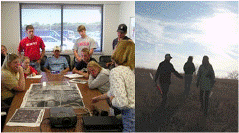Environmental Studies Program
Date of this Version
Fall 12-2011
Abstract
Studies have indicated that non-consumptive outdoor recreation may affect wildlife. Thus, as the nation increases interest in outdoor recreation, data suggests the effect on wildlife will also increase. Previous studies indicate that as disturbance to wildlife increases, both avian species richness will decrease. Knowing how to anticipate effects on native species when planning and managing recreational areas is important in order to both provide for human desires and ensure the least impact to local species diversity.
The goal of this project was to observe and compare avian species richness and diversity between selected trail sites within Shevlin Park, Bend, Oregon (Figure 1). Trail patronage was then compared to species richness and diversity at three selected sites (#1: with high use, #2: with moderate-low use, and #3: void of a trail system).
This study found sites at Shevlin Park with trail systems to have a higher avian species richness and diversity in comparison to the site void of a trail system. Both Site #1 and #2, displaying heavy to moderate trail use, had nine different avian species (Table 1). Site #3, without trails, was observed to only have four different avian species (Table 1).
Included in
Environmental Health and Protection Commons, Environmental Monitoring Commons, Poultry or Avian Science Commons, Sustainability Commons, Terrestrial and Aquatic Ecology Commons, Zoology Commons

